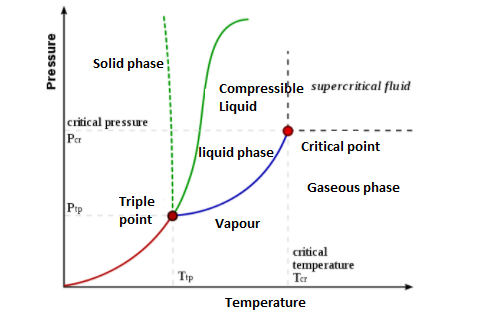
How can you tell density from a phase diagram?
Answer
456k+ views
Hint: You should know how the phase diagram is drawn for different molecules. The phase diagram shows the change in the phase of the molecule from one state to another. Solid is denser than liquid and liquid is denser than gas.
Complete step by step answer:
Phase diagram is a graphical representation used for showing the physical states of a substance under different conditions of temperature and pressure. In a typical phase diagram pressure is present on the y-axis and the temperature is present on the x-axis.
A phase transition is defined as the transition taking place from one state of matter to the other. There are three states of matter: Solid, liquid and gases.
The phase diagrams show variations between the states of matter of an element in relation with the pressure and the temperature.

The labels given in the graph shows the stable states of the system present in equilibrium. The lines present show the combination of pressure and temperature at which the two phases can exist in equilibrium. These lines represent the change in phase point. The red line divides the solid and gas phases which shows sublimation process (change of phase from solid to gas) and deposition process (change of phase from gas to solid). The green line divides the solid and liquid phases and represents the melting process (change of phase from solid to liquid) and freezing process (change of phase from liquid to solid). The blue divides the liquid and gas phases, represents the vaporization process (change of phase from liquid to gas) and condensation (change of phase from gas to liquid). There are two other points on the diagram, the triple point and the critical point. The triple point shows the combination of pressure and temperature that facilitates all phases of matter at equilibrium. The critical point terminates the liquid/gas phase line and shows relation with the critical pressure, the pressure above which a supercritical fluid is generated.
When we move along the constant temperature line, the relative densities of all the phases can be determined. On moving from the bottom of the diagram to the top, the relative density increases.
Note:
As we move along the constant pressure line, the relative energies of the phases is determined. As we move from left to right in the diagram, the relative energy increases.
Complete step by step answer:
Phase diagram is a graphical representation used for showing the physical states of a substance under different conditions of temperature and pressure. In a typical phase diagram pressure is present on the y-axis and the temperature is present on the x-axis.
A phase transition is defined as the transition taking place from one state of matter to the other. There are three states of matter: Solid, liquid and gases.
The phase diagrams show variations between the states of matter of an element in relation with the pressure and the temperature.

The labels given in the graph shows the stable states of the system present in equilibrium. The lines present show the combination of pressure and temperature at which the two phases can exist in equilibrium. These lines represent the change in phase point. The red line divides the solid and gas phases which shows sublimation process (change of phase from solid to gas) and deposition process (change of phase from gas to solid). The green line divides the solid and liquid phases and represents the melting process (change of phase from solid to liquid) and freezing process (change of phase from liquid to solid). The blue divides the liquid and gas phases, represents the vaporization process (change of phase from liquid to gas) and condensation (change of phase from gas to liquid). There are two other points on the diagram, the triple point and the critical point. The triple point shows the combination of pressure and temperature that facilitates all phases of matter at equilibrium. The critical point terminates the liquid/gas phase line and shows relation with the critical pressure, the pressure above which a supercritical fluid is generated.
When we move along the constant temperature line, the relative densities of all the phases can be determined. On moving from the bottom of the diagram to the top, the relative density increases.
Note:
As we move along the constant pressure line, the relative energies of the phases is determined. As we move from left to right in the diagram, the relative energy increases.
Recently Updated Pages
Master Class 11 Economics: Engaging Questions & Answers for Success

Master Class 11 Business Studies: Engaging Questions & Answers for Success

Master Class 11 Accountancy: Engaging Questions & Answers for Success

Master Class 11 English: Engaging Questions & Answers for Success

Master Class 11 Computer Science: Engaging Questions & Answers for Success

Master Class 11 Maths: Engaging Questions & Answers for Success

Trending doubts
What are Quantum numbers Explain the quantum number class 11 chemistry CBSE

Write the differences between monocot plants and dicot class 11 biology CBSE

The reason why India adopted the policy of nonalignment class 11 social science CBSE

List out the uses of ethanoic acid class 11 chemistry CBSE

The process in which gas transform into solid is called class 11 chemistry CBSE

The heart of a computer is A CPU B Memory C Input D class 11 computers CBSE




